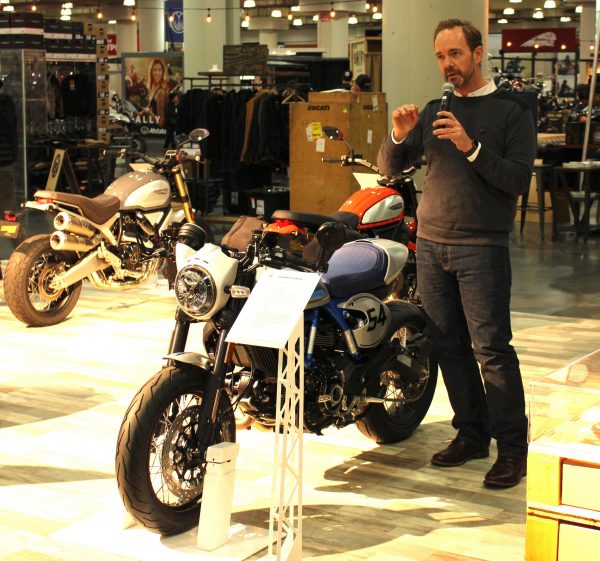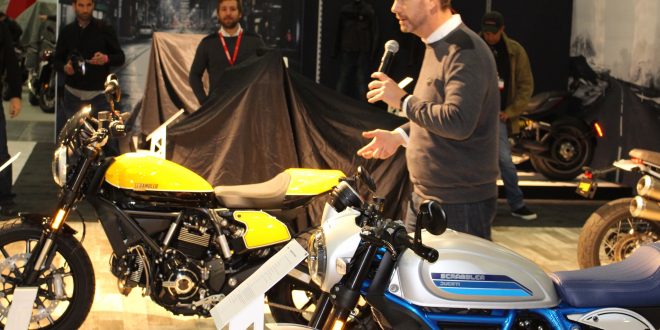 off and younger riders don’t replace them.
off and younger riders don’t replace them.
You’d think that the industry would galvanize, step up and fight back against eroding popularity. Instead, there’s been a lethargic, status quo response. Yes, there are an increasing number of fresh and smaller models aimed at new, more youthful and urban dwellers, but there has been no “big picture” effort.
The CEOs of the major manufacturers continue to draw huge salaries and bonuses, so presumably do the long-ensconced executives at industry organizations like the American Motorcyclist Association or the Motorcycle Industry Council. This leaves the impression that they’ve “got theirs” and the heck with the industry’s future. The “same old, same old” works for them.
Remember the “You meet the nicest people on a Honda” advertising campaign from the 1960s? It single-handedly changed the public’s perception of motorcycles and riders. Recall the more recent “Got milk?” campaign? It, too, was a broad welcoming effort that invited action by everyone.
So why are industry leaders missing in action in kick-starting motorcycling?
At the recent Progressive International Motorcycle Show in New York, RIDE-CT talked with two men who actually have the ability bring about change – public relations specialist Robert Pandya and Ducati executive Jason Chinnock – about the current situation and what needs to be done to raise motorcycling’s profile.

Pandya is the owner of SpokesPeople, LLC. He previously was company spokesman for Indian and the now-defunct Victory brand. Pandya was at the IMS staging a participatory exhibit called “Discover the Ride.” Working with Zero Motorcycles, he coaxed non-riders to learn about motorcycling aboard detuned electric Zero models.
So why has the industry done such a poor job in self-promotion?
“Sometimes we live in the forest too much. We’re always around ourselves. We’re always around people who know motorcycling. Really the challenge of the industry to get new riders in is to get out of our world; to really understand what it is that new riders need,” said Pandya, explaining that sometimes it can come down to something as basic as sharing in which direction a bike’s throttle needs to be turned to take off.
Riding can be scary and intimidating to the uninitiated. But before fears can be quelled, the industry must admit that a problem exists. “I think there are parts of this industry that have seen that there are certainly problems or gaps within how we’re addressing the public out there. Motorcycle manufacturers, by and large, really focus in on product. It’s their job to sell nuts and bolts and products. That’s what they do,” said Pandya.
“Therefore, the extra stuff sometimes that comes around community and comes around the ancillary part of a product doesn’t get the same budget, doesn’t get the same attention, doesn’t get the same quality of people.”
For the industry to rebound, it will take more than product. “The reality for a brand to win is to sell heart and soul and to tell a story. This is a very human endeavor that we do. It’s the reason that motorcyclists are such an amazing community is because you connect on a human level,” Pandya continued.
“The challenge for us as an industry is to really get together in a way of embracing constructive criticism, and constructive criticism isn’t to blame or isn’t to say ‘Oh, you’re not good at this,’ it’s to say ‘How can we be better?’ and really look at that.”

Chinnock, meanwhile, is CEO of Ducati North America. He, too, sees a need to get non-riders enthused. “It’s our responsibility to not only bring product to market but to point people in the direction of the tools that they have in order to learn how to ride,” he said.
Ducati has a wide product range and a wide range of MSRPs. “Our approach has actually been less focusing on any sort of age group or specific demographic and more about people that actually have something that’s in them. That’s the spirit of adventure that actually makes you want a motorcycle,” Chinnock said.
“There’s a spirit that’s within people that doesn’t matter their age that maybe needs to be awoken,” he said, noting that after his mother passed away his father took up riding. “I believe that motorcycling has an opportunity to grow by finding a way to ignite that with people, regardless of age and demographics.
“We are not in the transportation business,” he said, reaching down to touch a Scrambler model on display in the Ducati exhibit. “This is not transportation. This is entertainment. What we’re fighting for, challenging if you will, (is) what they’re doing with their discretionary spending and their time.”
Part of the industry’s decline is self-inflicted. It focused for so many years by selling huge cruisers to baby boomers, ignoring Gen Xers and their offspring, who, Pandya said, were given a “screen as a pacifier” and consequently never adopted riding, either.
“The real opportunity for this industry right now to replace baby boomers is to market to Generation X because all of a sudden we have a whole generation, they’re free again. Kids are out and they’re looking for the next thing,” Pandya said, who retains some optimism for the future.
“We still have a compelling story. To get on a motorcycle, to control that bike, to go down the road, to feel the wind, to be part of the community … that is a timeless, compelling story. That’s never going to change. Changing it through just product is not the answer. Changing it through attitude and changing it through a changed perspective, ultimately, that’s the answer to grow our industry.”
Too bad so few entrenched industry leaders buy in.
(This column originally appeared in the “Republican-American” on Dec. 15, 2018.)
 Ride CT & Ride New England Serving New England, NYC and The Hudson Valley!
Ride CT & Ride New England Serving New England, NYC and The Hudson Valley!



I’ve been heavily involved in the sailing industry, which has suffered the same problem after decades of catering only to the high-end. In the past there were many entry points and baby steps that could bring in new riders. My Dad purchased a 125cc Suzuki, then went up to a 250, then a 550, etc. The 125 was a perfect bike for me to learn on when I was a teenager. What Dad is going to let his teen child “try out” his 1000cc, mega powerful, mega heavy ride that costs more than a lot of cars? The other factor is our high school sports climate that means a lot of kids and families are booked solid every waking hour between school, after school sports, weekend travel teams, and summer practice. There’s just no time for children and families to mess about with small motorcycles, repairing them in the backyard, and getting the bug for a lifetime passion.
Most industry “insiders” I have met are unimaginative and narrow focused. Unless the trade groups and combined rider groups make a real effort to excite and educate the non-riding public then our passion will be a small minority activity with decreasing sales year on year.
Motorcycling generally is crying out for a fresh marketing approach to the activity as a whole.
I think Jason and Robert both have some very good points here. All manufacturers must understand that they need to help grow the top of the sales funnel by getting more people interested in motorcycling. They have to create interested in the sport/hobby and COMMUNITIES within motorcycling before they care about the “nuts and bolts” as Roberts says. It’s more important for companies to define and sell their brand’s communities, or tribes, to potential customers who are making decisions on where they and their discretionary dollars and TIME belong. Jason is so correct that in America we are in the transportation industry. Motorcycling is trying to keep a slice of the pie among fishing, biking, boating, hunting and all the other hobbies or sports people can participate in. Put more money into marketing a lifestyle and less into engineering faster bikes. Look at how millenials are attracted to the motorcycle builder culture as much as they’re into the aspect of actually riding motorcycles. .
If Jason Chinnock thinks a few Generation X’s returning to riding will save things then he is a perfect example of the problem within current management.
Thanks for the opportunity to take part in the story. I certainly am optimistic and encourage all of us to have these discussions together rather than in the vacuum of private groups or OEM conference rooms. I believe that the future of our motorcycle industry from a further reaching perspective is via Strider bicycles and electric training motorcycles.
Yes,let the big boys follow Edward Turner’s lead. We all know where that led….I think the future will show that companies like Royal Enfield and now Jawa (now from India too) with their mid-size bikes will sell well. As,I think,will real world 250-500cc (not ricky racers) bikes will do well too. Make them light,not too much tech,easy to handle with enough power and great gas mileage,reasonably priced. Actually the Ducati Scrambler is pretty much there now. Well,there’s my 2cents worth….LouA